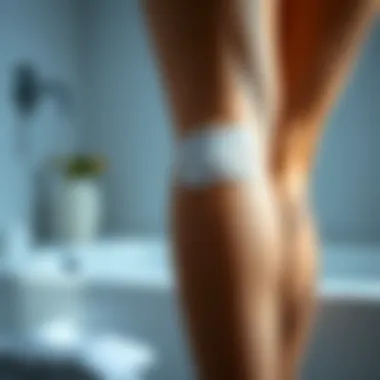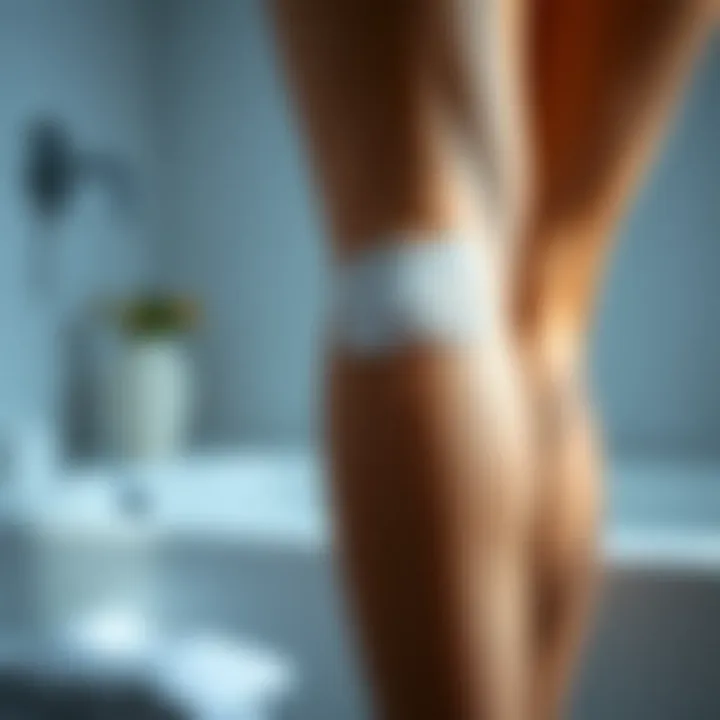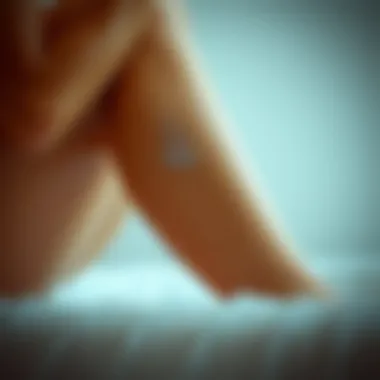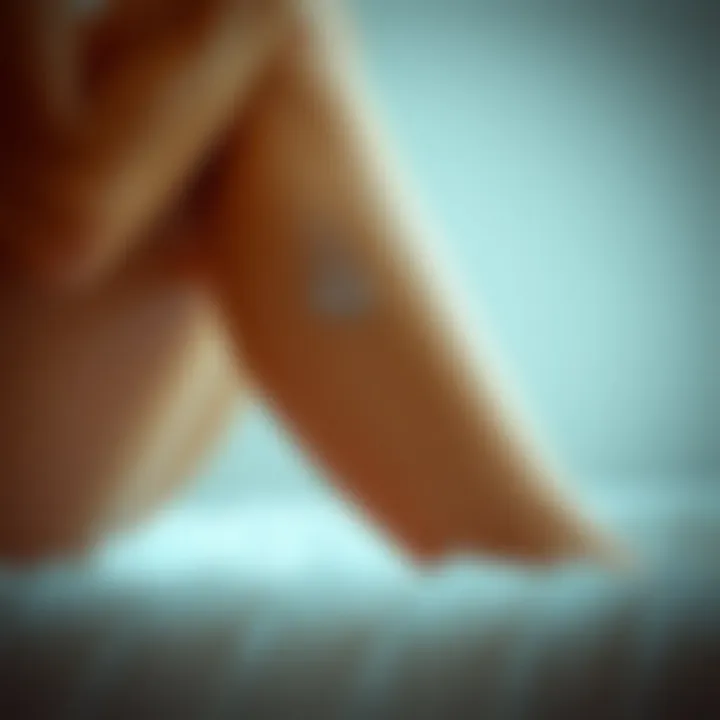Effective Strategies to Prevent Shaving Bumps on Legs


Intro
Shaving the legs can be a mundane ritual for many women, yet the aftermath often comes with its own set of challenges. After all, smooth skin is the goal, but bumps and irritation can throw a wrench in the works. By understanding the common culprits of post-shave bumps and employing effective techniques, it's possible to reclaim the skin's natural softness.
This guide is crafted to provide a well-rounded strategy to prevent bumps on your legs after shaving. From preparing the skin to implementing the right techniques and following up with effective aftercare, this article covers it all. If you find yourself struggling with red bumps, here’s a roadmap that could lighten your load.
Trending Topics
With beauty innovations constantly emerging, knowing what’s hot in skincare can make a difference. Women today are more aware of skin health and beauty routines than ever before. Let’s look at the latest trends in skincare that align with our shaving focus.
Current Fashion Trends
Smooth, hair-free legs are not just a seasonal trend; they are a fashion staple. Whether it’s the allure of a summer dress or the chicness of shorts, having perfectly groomed legs is often part of the package. Current trends in fashion often promote leg-baring outfits, pushing the need for effective shaving practices to the forefront. It's important to stay current, not just in clothing but also in skincare routines that augment confidence when wearing these styles.
Beauty Innovations
In the realm of skincare, several innovations have appeared aimed at improving the shaving experience. For instance, moisturizing shaving creams or gels have taken center stage, addressing the common issue of skin irritation. One product, the Billie razor, emphasizes moisture strips that promise to lessen nicks and bumps, while another, the Flamingo Shave Kit, offers a well-rounded approach to women’s shaving needs.
In addition, many brands are now incorporating natural ingredients into their formulations, reducing the risk of allergic reactions and promoting skin health, something that is increasingly important to the discerning consumer.
Step-by-Step Guides
Now that we have our finger on the pulse of current beauty innovations, let’s pivot to practical tips—how can these ideas be transformed into tangible steps for everyday use?
Shaving Preparation
- Exfoliate Regularly: Use a gentle scrub or a loofah one to two days before shaving. This helps remove dead skin cells and can prevent ingrown hairs.
- Moisturize Before Shaving: Hydrating the skin before you take a razor to it makes a big difference. Apply a soothing lotion or oil ahead of time.
- Choose the Right Tools: Opt for a sharp, clean razor. Dull blades increase the risk of irritation. Don’t skimp on quality; often, spending a little more on a dependable razor pays off.
Shaving Techniques
- Shave with the Grain: Always begin by shaving in the direction of hair growth to reduce the risk of bumps.
- Gentle Strokes: Don’t press down too hard. Light strokes help maintain the integrity of the skin and prevent irritation.
- Rinse Often: Rinse the blade frequently to remove hair and shaving cream build-up. A clean blade does a better job and is less likely to cause irritation.
Post-Shave Care
- Immediate Aftercare: Rinse the legs with cool water after shaving to close the pores.
- Apply a Soothing Lotion: Look for products with aloe vera or tea tree oil, which can calm irritation.
- Avoid Tight Clothing: For the day following your shave, steer clear of tight fabrics that might rub against the freshly shaved area.
"Prevention is better than cure—when it comes to post-shaving bumps, that couldn’t be more true. Planning ahead leads to smoother results."
Product Reviews
This section will offer deeper insights into specific products that align with our mission to achieve smoother legs post-shaving. Understanding what’s available can empower women to make informed choices.
In-Depth Analysis of Popular Items
Product choices can vary widely from store-bought razors to luxurious shaving oils. For example, the Schick Hydro Silk Razor is often praised for its moisturizing blades that help ease the drag of the shave.
Comparative Reviews
Also, comparing brands can demystify which products might work best for different skin types. The difference between drugstore items and premium products can be worth examining, especially for those prone to irritation.
Culmination
To avoid bumps on your legs after shaving, understanding your skin's needs is crucial. From the tools you use to the aftercare you implement, there's a spectrum of care that can lead to not just smoother, but healthier skin. With the right preparations and techniques, those unwanted bumps can become a mere afterthought.
Understanding Shaving Bumps
When it comes to the delicate art of shaving, the last thing anyone wants is the pesky aftermath of unsightly bumps. Understanding shaving bumps is crucial, as it not only informs how to tackle them but also gives insight into skin care practices that promote smoothness. Having a grip on this topic means avoiding a lot of discomfort later on.


What Are Shaving Bumps?
Shaving bumps are essentially small, reddish or inflamed spots that can appear following the shaving process. Scientifically known as pseudofolliculitis barbae, they occur when hair grows back into the skin rather than out of it. While they often occur in areas where hair is dense, like the legs, they can also pop up on the face or armpits. Experiencing these bumps is not just a cosmetic issue; they can also cause itching or pain.
Causes of Shaving Bumps
Shaving bumps usually result from a combination of various factors. Here’s a breakdown of some common culprits:
- Improper shaving technique: Not shaving in the right direction or pressing too hard can contribute to bumps.
- Clogged pores: Dead skin cells can block hair follicles, creating a perfect storm for bumps to form.
- Skin irritation: Using harsh products or shaving too frequently can lead to sensitive skin and irritations.
- Blunt blades: A dull razor can cause hair to become trapped beneath the skin surface, instead of cutting cleanly.
Understanding these factors can help in formulating a personalized approach to prevention.
The Role of Skin Type
Every woman's skin is unique. Different skin types react variously to shaving, which is important to keep in mind. For instance:
- Oily skin may be more prone to buildup or irritation from products not meant for oily types.
- Dry skin might suffer more from cuts or irritations if not properly prepared before shaving.
- Sensitive skin is notoriously reactive, and using heavy or chemical-laden products can lead to significant discomfort.
Using the right products and techniques tailored to one's specific skin type can significantly reduce the occurrence of bumps post-shaving.
Pre-Shaving Preparation
Getting ready to shave is no small feat, especially if you want to avoid those pesky bumps that can interrupt an otherwise smooth experience. The pre-shaving phase is vital—it lays the groundwork for ultimate skin comfort and effective hair removal. When you take the time to prepare your skin properly, you're more likely to achieve a close shave without the irritation or redness that follows. It’s not just about picking up a razor and going to town; there’s a bit of strategy involved.
Skin Cleansing Techniques
Before the first stroke of the razor, think about cleansing your skin. Washing your legs with a gentle soap not only removes dirt and oils but also preps your skin for the razor’s glide. Opt for a mild, fragrance-free cleanser to avoid stripping your skin's natural moisture. You want it clean, but not squeaky.
- Warm Water: Start with warm water—this helps open up your pores, making hair removal a bit easier. Cold water can cause your pores to tighten, making shaving more of a chore than it should be.
- Pat, Don’t Rub: After you wash, pat your skin dry with a soft towel rather than rubbing it. Rubbing can cause micro abrasions, inviting irritation right from the get-go.
- Face Wash as an Option: For those who might prefer, a gentle face wash can also double as a leg cleanser; its formulation is often designed to be less harsh than body washes.
"Squeaky clean doesn’t mean smooth; it means stripped of what’s necessary. Remember that as you start your shaving routine."
Exfoliation Methods
Next up is exfoliation. This process isn’t just a fad; it’s a crucial step that can make or break your shaving experience. Exfoliating helps remove dead skin cells that can clog hair follicles and lead to ingrown hairs—one of the main culprits behind shaving bumps.
- Physical Exfoliation: Consider using a body scrub with sugar or salt. These granules can help slough away dead skin without being overly harsh. Make gentle, circular motions, and don’t go overboard; too much can irritate sensitive skin.
- Chemical Exfoliation: Alternatively, products with alpha-hydroxy acids (AHAs) can promote skin renewal without the scrubbing action. These can help keep your skin smooth and may even help with future bumps by encouraging hair to grow out correctly.
- Frequency: Exfoliating two to three times a week is generally sufficient. Too often? You might end up with inflamed skin, which really isn’t the goal here.
Choosing the Right Moisturizer
After cleansing and exfoliating, it’s time to slap on the moisturizer. But not just any moisturizer will do. You need something that hydrates but doesn’t leave behind a greasy feeling. A well-chosen moisturizer can create a barrier that helps the razor glide smoothly while also keeping your skin hydrated.
- Look for Non-Comedogenic Formulas: These won’t clog your pores, which is key because the last thing you want is for your skin to rebel after you just treated it nicely.
- Ingredients Matter: Ingredients like aloe vera or shea butter can be beneficial. They help soothe irritated skin while providing moisture. Steer clear of heavy fragrances or alcohol-based products that might aggravate your skin.
- Apply Generously: A proper application before shaving will go a long way. It's not just a light dab; you want enough product to ensure a good glide for your razor.
In summary, pre-shaving preparation is about setting the stage for a smoother experience. By cleansing, exfoliating, and moisturizing, you're gearing up for an effective shave and significantly reducing your chances of developing those unwanted bumps.
Selecting Shaving Tools
When it comes to achieving smooth legs without the dreaded bumps, choosing the right shaving tools is half the battle. The tools you select can greatly influence the outcome of your shaving experience, determining both the immediate results and the longer-term health of your skin. The right razor not only reduces the risks associated with shaving but also enhances comfort and promotes an enjoyable routine.
Choosing the Right Razor
There are several factors to consider when picking a razor for leg shaving. A versatile option is the multi-blade razor, which, as most women know, can offer a closer shave. However, it's not just about the number of blades; the flexibility of the razor head also plays a key role. A pivoting head can adapt to the contours of your legs, making it easier to navigate tricky areas without applying too much pressure. Alternatively, disposable razors can be a cost-effective choice for those who shave frequently. Nevertheless, it’s crucial to ensure that any disposable blade is designed with skin-friendly features, such as a moisturizing strip.
Importance of Sharp Blades
Using sharp blades cannot be overstated. A dull blade does not slice through hair efficiently; instead, it pulls at the hair follicles, which can lead to irritation and, ultimately, those pesky bumps. Not only does a sharp blade cut hair cleanly, but it also navigates smoothly across your skin, reducing friction and minimizing the chances of nicks. It’s a good idea to replace blades every five to seven shaves, or sooner if you notice any tugging while shaving. Keeping your blades sharp is the first step in ensuring a gentle and effective shaving experience.


Razor Types Comparison
The market is flooded with various types of razors, each boasting unique benefits. Here’s a quick comparison to help you select the one that suits you best:
- Safety Razors: These razors are effective in providing a close shave. Unlike multi-blade razors, they require a bit of skill but can help minimize irritation once mastered.
- Electric Razors: These are great for those looking for convenience. While electric razors might not give the closest shave, they are less likely to cause cuts and irritation. Some models are perfect for sensitive skin and can be used for both wet and dry shaving.
- Straight Razors: While they offer the closest shave, they require utmost precision and care. These razors are not for the faint-hearted but can be rewarding.
- Cartridge Razors: Popular for a reason, these razors offer flexibility, ease of use, and multiple blades. They’re great for quick touch-ups but remember to replace cartridges regularly.
In the end, the best razor is one that feels comfortable for you and gives the desired results without irritation. A thoughtful selection of your shaving tools sets the stage for smooth and bump-free skin after each shave.
"The road to smooth legs is paved with the right tools and a little know-how."
Take your time in assessing your options, as investing in quality tools can drastically improve your shaving experience.
Shaving Techniques
When it comes to achieving smooth legs without unsightly bumps, the techniques used during shaving play a crucial role. Proper technique can mean the difference between irritation and a clean shave. Taking time to understand how to effectively remove hair while being gentle on your skin can yield significant benefits. For many women, avoiding bumps after shaving is a recurring challenge, but honing your techniques can make all the difference.
Shaving Direction and Technique
Choosing the right direction when you shave is vital. It’s generally recommended to shave in the direction of hair growth. This means that instead of dragging the razor against your hair's natural path, you gently follow it. Shaving against the grain can cause more irritation, leading to those pesky bumps.
When you’re shaving,
- Use light pressure on the razor; there’s no need to press down hard.
- Short strokes work better than long ones, as they give you more control.
- Avoid multiple passes over the same area, as this can cause friction and irritate the skin.
Adopting these methods not only minimizes bumps but also leaves a supple finish that you’ll appreciate once you see the smoothness of your legs. Williams Skin health experienced another boost when they combined proper shaving with the correct tools (discussed earlier).
Using Shaving Creams and Gels
One cannot underestimate the importance of a good shaving cream or gel. These products create a barrier between the razor and your skin, ensuring that the shave is as smooth as possible.
Consider these factors when choosing and using your product:
- Hydrating components like aloe vera or glycerin can help retain moisture in your skin while shaving.
- Opt for creams or gels designed for sensitive skin if you have a reaction-prone complexion.
- Apply a generous layer; this isn’t a time to skimp, as it protects your skin and allows for a better glide of the blade.
After lathering, let the cream or gel sit for a minute to soften the hair; this can significantly diminish the resistance during shaving. The richer the lather, the more it protects you from cuts and irritation, and the overall experience feels much better.
Timing and Frequency of Shaving
Timing plays a critical role in minimizing post-shave bumps. The best time to shave is after a shower; this is when your hair is softer, making it easier to cut. Bathing in warm water helps open up the follicles, which can reduce the risk of irritation.
As for frequency, shaving too often can exacerbate problems. Here are some simple guidelines to consider:
- If your hair grows quickly, consider shaving every other day, rather than daily.
- Watch for signs of irritation. If you notice bumps frequently, maybe give it a rest for a couple of days.
- Track your shaving schedule; this way, you can find the right balance that works for your skin.
"Finding the right timing and method can make shaving a soothing routine rather than a chore, ultimately enhancing your skin health."
By understanding these shaving techniques and applying them thoughtfully, you make significant strides towards banishing bumps on your legs. Finding the right balance between preparation, technique, and post-care improves your shaving experience immensely. In this quest for smooth skin, every detail counts.
Post-Shaving Care
Post-shaving care is not just a final step; it's an essential part of the whole shaving process. While pre-shaving preparation and shaving techniques are vital, the aftercare can make the difference between smooth, radiant skin and an itchy, uncomfortable mess. This section delves into the important elements of post-shaving care that can significantly minimize irritation and promote skin health.
Soothing Irritated Skin
After shaving, the skin may feel sensitive or even a tad raw. This irritation is often due to the loss of natural oils and the trauma caused by the razor. To tackle this, it’s crucial to soothe the skin effectively. Here are some methods that can prove beneficial:
- Cold Compress: Applying a cold cloth can help reduce redness and calm irritation. Simply take a clean cloth, soak it in cold water, and press it gently against your legs.
- Aloe Vera Gel: This natural remedy is quite effective for soothing the skin. Its anti-inflammatory properties help to cool down the skin and reduce swelling. You can either use fresh aloe from the plant or opt for a store-bought gel without added fragrances.
- Chamomile Tea: Brew some chamomile tea and let it cool. The tea bags can also be placed on the irritated areas for a few minutes to soothe and calm the skin.


These remedies not only help with discomfort but also support the skin’s healing process, reducing the chances of developing those pesky bumps.
Recommended Aftershave Products
Choosing the right aftershave product follows the immediate post-shave care. These products can help maintain skin health while providing essential moisture and protection. Keep an eye out for the following types of products:
- Alcohol-Free Aftershaves: Many traditional aftershaves contain alcohol, which can further irritate the skin. Opt for ones that are alcohol-free, like those made with witch hazel, which provides a gentle astringent effect without the harshness.
- Balm or Lotion with Natural Ingredients: Look for options that include soothing ingredients like vitamin E, shea butter, or any other natural oils. These moisturizers can offer hydration and form a protective barrier over the skin.
- Gel Formulations: If your skin tends to be more sensitive, consider gel products that absorb quickly and don’t leave a greasy residue, which can feel heavy post-shave.
Utilizing the appropriate aftershave product can make the skin feel comfortable while also helping to prevent infection and bumps from forming.
Hydration and Moisturizers
Hydrated skin is less prone to irritation and discomfort. Hence, keeping your skin moisturized after shaving is key. Here are a few things to keep in mind when it comes to hydration:
- Moisturizers with Hydrating Ingredients: Seek out products that are rich in humectants like hyaluronic acid, glycerin, or ceramides. They can lock in moisture effectively and create a protective barrier on the skin.
- Daily Hydration Routine: Implement a daily moisturizing routine, especially focusing on post-shaving days. Applying moisturizer immediately after rinsing off all shave products can capture moisture and ensure the skin stays supple.
- Drink Plenty of Water: Internal hydration should not be overlooked. Keeping hydrated helps the skin retain moisture and can improve its overall appearance.
Additionally, consider incorporating a weekly exfoliation that aligns with your moisturizing routine. Gentle exfoliation can prevent dead skin cells from clogging pores, which in turn decreases the likelihood of bumps forming in the first place.
Remember, taking care of your skin after shaving isn’t just about comfort; it's about prevention and maintaining long-term skin health.
"Invest in your post-shave care; your skin will thank you in the long run."
These strategies help combat post-shaving bumps and irritation, allowing for smoother, healthier-looking skin. Don't underestimate the power of good post-shaving care; it can be the secret ingredient for an enjoyable shaving ritual.
Preventative Measures
Taking proactive steps to prevent bumps on the legs after shaving is crucial for anyone seeking smooth skin. Bumps can not only be a nuisance but may also lead to discomfort and embarrassment. By focusing on preventive strategies, it’s possible to minimize irritation before it even occurs. This section emphasizes understanding skin health and how lifestyle choices affect your shaving experience.
Maintaining Skin Health
Preserving skin health is not merely a matter of using the right products—it's a holistic approach that involves listening to your skin's needs. Start by identifying your skin type. Is it oily, dry, normal, or a combination? Knowing this can guide product and method choices. Regular exfoliation is key; it lifts dead skin cells which might otherwise clog pores, leading to bumps. Gentle exfoliants, such as those containing lactic acid or glycolic acid, can provide both physical and chemical exfoliation. Incorporate this into your routine about twice a week, but be mindful not to overdo it, which can lead to irritation.
Also, maintaining a consistent moisturizing routine is vital. Look for moisturizers that contain ingredients like hyaluronic acid or natural oils, which help in creating a barrier against irritants. To summarize:
- Identify your skin type
- Exfoliate regularly but gently
- Moisturize consistently to keep the skin's barrier intact
Diet and Hydration
What you put into your body is just as important as what you apply on your skin. A well-rounded diet rich in vitamins, especially A, C, and E, can contribute positively to skin health. Zinc, found in nuts and seed, can be beneficial for healing and reducing inflammation. Additionally, don’t underestimate the importance of hydration. Drinking adequate water supports overall health and can aid in keeping skin pliable and less prone to irritation. When planning meals, don’t forget:
- Incorporate antioxidant-rich foods like berries, leafy greens, and nuts
- Avoid processed foods which may contribute to skin problems
- Drink at least 8 cups of water a day to promote skin elasticity
Long-Term Hair Removal Options
For those tired of continuous shaving and the subsequent battle with bumps, exploring long-term hair removal methods may provide relief. Options like laser hair removal and electrolysis can significantly reduce hair growth over time, leading to smoother skin and fewer shaving incidents. These methods work by targeting hair follicles and reducing their ability to grow hair. While they may require a higher upfront investment, the long-term benefits can outweigh the costs.
It’s essential to consult with a licensed practitioner to discuss your options and understand the associated risks and benefits. Popular options include:
- Laser Hair Removal: Targets pigment in hair follicles, usually requires several sessions.
- Electrolysis: Works for all hair types and is FDA-approved for permanent hair removal.
- Waxing: Provides smooth results for weeks but might also lead to irritation if not done correctly.
By implementing these preventative measures, individuals can cultivate a routine that not only addresses current bump issues but actively promotes better skin health and overall comfort for the future.
Closure
In wrapping up the insights on preventing bumps on the legs after shaving, it becomes clear that taking an informed and considerate approach to shaving can significantly improve outcomes for many women. It's not merely about achieving hair-free skin; it’s about doing so in a way that respects and nurtures the skin's delicate nature. The combination of proper preparation, selecting the right tools, employing effective techniques, and practicing post-shaving care plays a pivotal role.
By prioritizing pre-shaving hygiene and using the right products, the skin is less likely to react negatively. The techniques used during shaving, such as adhering to the direction of hair growth, avoiding excessive pressure, and incorporating shaving gels, also greatly influence the results. Lastly, the aftercare routine cannot be overstated; soothing irritated skin and ensuring it remains hydrated is key to maintaining a healthy complexion.
"Effective shaving isn’t just a routine; it’s a form of self-care that acknowledges the needs of the skin."
Not only does understanding these elements help in preventing bumps, but it fosters a holistic view of personal care. Each step, from preparation to aftercare, creates a chain reaction leading to smoother skin and enhanced confidence. As every individual is unique, experimenting with different methods tailored to one's skin type can yield the best results.
In essence, investing time in ongoing care and education about effective shaving techniques is critical. Understanding personal needs, the ingredients used in products, and how various techniques affect the skin will not only prevent immediate issues but also contribute positively to long-term skin health.
Beautiful skin is not a coincidence; it’s the byproduct of careful attention and knowledge. Each woman can navigate her own shaving journey with the right information and practices.



